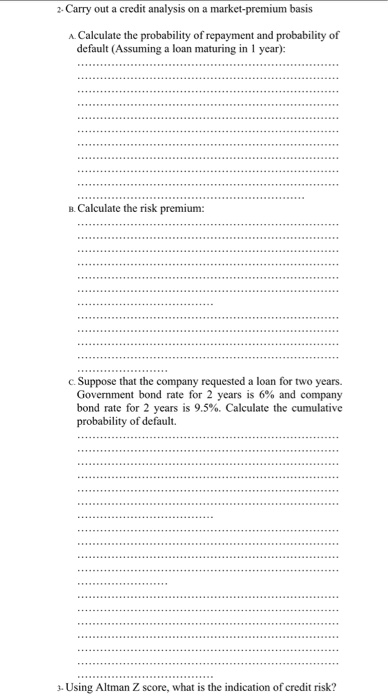Part 2: Problem Solving A financial services provider that provides computer software systems approaches you. The company started off as a small private company and has grown strongly over the past fifteen years and listed on the Australian Stock Exchange. The company has businesses in many offshore locations, all of which are well-developed capital markets. In some parts of the world, the company has near-monopoly markets. As part of its strategy, the company uses acquisitions rather than growth to continue to expand the business. While the business is software based, it relies on continued activity in the financial markets. The company has had the same management over the past fifteen years and the senior management team are shareholders in the company. The company is rated BBB and its bonds are trading at 3.3 per cent above the comparable government bond rate (5%). These rates are for a 1-year period. Your bank's experience is that the recovery rate in the event of default, the recovery rate is 50 per cent. The condensed financial accounts are as follows: SM Total current assets 66.3 Total noncurrent assets 659.9 Total assets 726.2 Total current liabilities 197.3 Total noncurrent liabilities 243.7 Total liabilities 441.0 Shareholders' equity 546.7 Retained earnings 84.0 Total Equity 648.7 Earnings before interest and tax are $151,608,000 on sales of $742,613,000. The firm is requesting a loan of S150 million to assist further acquisitions. Ratio industry averages: Current ratio = 3 Inventory turnover ratio = 6 Net profit to sales ratio 0.15 Debt to Equity ratio = 0.4 Questions: 1- Carry out a credit analysis on an expert basis. 2. Carry out a credit analysis on a market-premium basis 1. Calculate the probability of repayment and probability of default (Assuming a loan maturing in 1 year): Calculate the risk premium: c. Suppose that the company requested a loan for two years. Government bond rate for 2 years is 6% and company bond rate for 2 years is 9.5%. Calculate the cumulative probability of default. 3. Using Altman Z score, what is the indication of credit risk? Part 2: Problem Solving A financial services provider that provides computer software systems approaches you. The company started off as a small private company and has grown strongly over the past fifteen years and listed on the Australian Stock Exchange. The company has businesses in many offshore locations, all of which are well-developed capital markets. In some parts of the world, the company has near-monopoly markets. As part of its strategy, the company uses acquisitions rather than growth to continue to expand the business. While the business is software based, it relies on continued activity in the financial markets. The company has had the same management over the past fifteen years and the senior management team are shareholders in the company. The company is rated BBB and its bonds are trading at 3.3 per cent above the comparable government bond rate (5%). These rates are for a 1-year period. Your bank's experience is that the recovery rate in the event of default, the recovery rate is 50 per cent. The condensed financial accounts are as follows: SM Total current assets 66.3 Total noncurrent assets 659.9 Total assets 726.2 Total current liabilities 197.3 Total noncurrent liabilities 243.7 Total liabilities 441.0 Shareholders' equity 546.7 Retained earnings 84.0 Total Equity 648.7 Earnings before interest and tax are $151,608,000 on sales of $742,613,000. The firm is requesting a loan of S150 million to assist further acquisitions. Ratio industry averages: Current ratio = 3 Inventory turnover ratio = 6 Net profit to sales ratio 0.15 Debt to Equity ratio = 0.4 Questions: 1- Carry out a credit analysis on an expert basis. 2. Carry out a credit analysis on a market-premium basis 1. Calculate the probability of repayment and probability of default (Assuming a loan maturing in 1 year): Calculate the risk premium: c. Suppose that the company requested a loan for two years. Government bond rate for 2 years is 6% and company bond rate for 2 years is 9.5%. Calculate the cumulative probability of default. 3. Using Altman Z score, what is the indication of credit risk








